The nuts and bolts of corpora A teaching sequence for using corpora in the scientific and technical translation classroom
Main Article Content
Abstract
This paper illustrates the application of corpora in the scientific and technical translation classroom. First, we review some previous works on teaching experiences with corpora and specialised translation. Then, we will present the teaching sequence we have applied in the subject Scientific and Technical Translation I BA-AB (English-Spanish/Spanish-English) of the BA in Translation and Interpreting at the University of Malaga. The main objective of this teaching experience was to familiarise our students with linguistic corpora and thus encourage them to using corpora as a translation tool. During the five sessions we dedicated to this topic, the students were able to learn more about what corpora are and how they can benefit from them as translators. First of all, they worked with reference corpora available on the net, both in Spanish (CREA, CORPES XXI) and in English (BNC, COCA). Then, they explored the different corpora accessible from Sketch Engine, as well as the numerous functions offered by this corpus analysis tool. Lastly, they compiled an ad-hoc technical corpus which they later used to translate an extract of a motorbike user’s manual. This teaching experience suggests that corpora are a very effective tool, as they enable translation students to solve a wide range of linguistic difficulties (terminological, conceptual, grammatical or stylistic).
Downloads
Article Details

This work is licensed under a Creative Commons Attribution-NonCommercial-ShareAlike 4.0 International License.
Authors who publish with this journal agree to the following terms:
1. Authors retain copyright and grant the journal right of first publication with the work simultaneously licensed under a Creative Commons Attribution License that allows others to share the work with an acknowledgement of the work's authorship and initial publication in this journal.
2. Authors are able to enter into separate, additional contractual arrangements for the non-exclusive distribution of the journal's published version of the work (e.g., post it to an institutional repository or publish it in a book), with an acknowledgement of its initial publication in this journal.
3. Authors are permitted and encouraged to post their work online (e.g., in institutional repositories or on their website) prior to and during the submission process, as it can lead to productive exchanges, as well as earlier and greater citation of published work (See The Effect of Open Access).

